|
In the ever-evolving landscape of college admissions, the phrase "test-optional" has emerged as an agent of change and transformation. As the United States navigates the post-affirmative action era, colleges and universities are fervently redefining their approaches to admissions. This shift towards test-optional policies has opened a new and exciting chapter in the pursuit of diversity, equity, and inclusivity within higher education. The traditional emphasis on standardized tests, such as the SAT and ACT, is giving way to a broader perspective that considers a student's holistic merits, extracurricular activities, and personal essays. These dynamic trends in college applications not only challenge the status quo but also reflect the ongoing quest for a more equitable and accessible educational landscape for all aspiring students.
The Rise of Test-Optional Policies: In the realm of college admissions, the term "test-optional" has been gaining significant traction, potentially staying mainstream perpetually. As the U.S. navigates the post-affirmative action landscape, colleges and universities are adopting a range of strategies to create more inclusive and equitable admission processes. This shift towards test-optional policies has opened up a new chapter in the pursuit of diversity, sparking discussions and revealing intriguing trends in college applications. The adoption of test-optional policies by colleges and universities across the United States has been a remarkable development since 2018 when University of Chicago, a notoriously academic heavyweight, first adopted the policy. Meeting the global pandemic, this shift has been largely driven by a desire to promote fairness and access in higher education. These policies acknowledge that standardized tests like the SAT and ACT can perpetuate socio-economic and racial disparities in admissions. As colleges strive to create a level playing field for all applicants, test-optional policies are a major step in the right direction. In 2023-24 application cycle, 1900 US colleges and universities deploy the measure, more than tripling the count in the beginning of 2020-21 cycle. A Broader Definition of Merit: Test-optional policies reflect a broader and more nuanced understanding of what constitutes merit in the college admissions process. Institutions are increasingly looking beyond test scores, recognizing the importance of assessing applicants holistically. This means that extracurricular activities, personal essays, and recommendation letters play a more significant role in evaluating a student's potential. The shift towards a more holistic evaluation of applicants represents a fundamental change in how colleges perceive merit. It's not just about test scores anymore; it's about the overall qualities and experiences that a student brings to the table. This shift emphasizes the importance of a well-rounded education and personal development, rather than just a focus on one’s grades, scores, and awards. Colleges of Brown and Tufts alike are accepting application videos from their students, while a growing number of others partner with third parties including Kira Talent and InitialView. BigFuture, the college guide portal at the duopoly of the standardized test, College Board, is too rumored to launch its own college video recording platform. In addition, personal essays and recommendation letters are also refilling the evaluation spaces giving up by scores and grades. The Impact on Underrepresented Communities: Test-optional policies have the potential to level the playing field for underrepresented minority groups. Students who may not have access to expensive test preparation resources or who have been historically disadvantaged by standardized tests now have a more equitable opportunity to be admitted based on their merits, rather than their test scores. This shift is particularly significant in addressing disparities in higher education. Historically, underrepresented communities have faced barriers in accessing and succeeding in college. Test-optional policies are a crucial step in breaking down these barriers and providing equal opportunities for all students, regardless of their background. Since the mid-year Supreme Court’s ruling on SFFA vs Harvard and SFFA vs UNC, affirmative action admission is considered to have retired from the front desks of the elite colleges. In their immediate reaction to the ruling, colleges updated and required a supplemental essay prompt on diversity, equality and inclusion topics, despite that the Common Application prompts has already included such a topic in the seven prompts. Harvard, for instance, has implemented a new required diversity prompt for 2023-24 cycle. In addition to QuestBridge that attracts nearly 20,000 application from underrepresented students, Common App through its newly launched Direct Admission program to offer admissions to 200,000 underrepresented students by 70 American colleges. The Role of Socio-Economic Background: While the move to test-optional policies is a step towards inclusivity, the socio-economic background of applicants still plays a significant role. Some students can afford test preparation courses and hire private admissions consultants, giving them an advantage. This highlights the need for ongoing efforts to address economic disparities in education. The socio-economic background of applicants remains a complex issue to address. While test-optional policies help reduce one dimension of inequality, the broader issues related to economic disparities in education persist. Colleges and policymakers need to work collaboratively to provide financial aid, resources, and support systems that ensure all students have a fair shot at higher education. Along this growing trend, dozens of colleges have joint Stanford, Princeton, and other endowment-rich elite institutions to instituting their own no-loan policies, largely limited to domestic candidates though. Currently. all but one top-20 universities required no debt to enroll. The average of financial aid for Yalies and Brownies who benefit from it amounts $58,244 and 47,590, respectively. The Challenge of Assessing Potential: One emerging trend is the challenge of assessing a student's potential without the anchor of standardized test scores. Admissions officers are tasked with a more subjective evaluation process, which can be both rewarding and daunting. This shift underscores the importance of investing in professional development for admissions teams and utilizing data analytics to predict student success accurately. The shift towards holistic assessment is not without its challenges. Admissions officers now have the responsibility of evaluating applicants in a more nuanced and subjective manner. This requires a greater understanding of the factors that contribute to student success and the development of tools and strategies to ensure accurate assessments. Colleges are investing in training and data analytics to support these efforts and make the transition as smooth as possible. Enrollment Management, an industry that have provided student search databases since 1980s, has been innovating itself and become dozens of providers in lieu of Royall, Encoura, and Turnitin that not only providing but also analyzing student databases composed of stats, essays, and activities among social networks. Ongoing Debates over Legacy Admissions: The SCOTUS ruling on affirmative action has also exacerbated debates about legacy admissions. Some critics argue that colleges should move beyond legacy admissions to create a more level playing field for all applicants. The spotlight on legacy admissions aligns with the broader discussions about fairness and equity in college admissions. The debate over legacy admissions has gained momentum in the context of post-affirmative action and post-pandemic admissions. Critics argue that legacy admissions perpetuate privilege and create an uneven playing field for other applicants. This discussion serves as a reminder that addressing inequality in college admissions is a multi-faceted challenge that requires reevaluating long-standing practices. Adding to a 2021 Stanford study unearthed the admission disparity among student application essays due to household income, a 2023 Harvard-Brown research covering 33 top private and public universities and 5 million students in 2010-2015 application cycles further exposed the privilege of legacy students, dubbing legacy factor as a college qualifier of its own. It is not to understate that parents legacy has started entering its way out of the admission domain. A Focus on Inclusive Practices: Many colleges are actively implementing practices that encourage diversity and inclusion. These include targeted outreach to underrepresented communities, expanding financial aid offerings, and providing support systems to ensure the success of students from diverse backgrounds. Colleges are not stopping at test-optional policies; they are actively pursuing inclusive practices to create a diverse and welcoming campus environment. Initiatives like outreach programs, increased financial aid, and support systems are essential components of these efforts. These institutions are making a conscious commitment to creating an environment where students from all backgrounds can thrive. Since 2020, institutions including University of California have been either opening dedicated positions on diversity admissions or hiring additional admission staff of certain underrepresented demographics. MIT, one that has least concerned the typical inequality measures like SAT and ACT scores, is now employing apparently 40% counselors and directors inside its undergraduate admission office. University of Pennsylvania uses its alumni networks in outreaching students of ethnic minorities and LGBTQ+. A Global Perspective: Test-optional policies have led to a more inclusive environment for international students. Colleges are increasingly looking beyond standardized testing, recognizing the value of diverse international perspectives in the student body. The impact of test-optional policies extends beyond domestic students. International students have also benefited from this shift, as colleges are now placing greater emphasis on a diverse and global student body. By moving away from an exclusive focus on standardized testing, colleges are inviting students from all over the world to contribute their unique perspectives to the academic community. China, where study abroad students were interrupted the most due to its pandemic travel limitations, has recovered to its pre-pandemic levels of common applications and is expected to rise further in 2023-24 cycle. India, one of countries leading the tolls on covid-19, has surpassed China and led the growths among all countries that are sending international students to the US. The Future of Standardized Testing: As colleges continue to embrace test-optional policies, questions arise about the future of standardized testing. Some institutions are considering alternatives, such as evaluating non-cognitive skills, to ensure a more comprehensive assessment of applicants. The future of standardized testing is uncertain as colleges increasingly move away from it. Some institutions are exploring alternative methods for evaluating applicants, such as assessing non-cognitive skills like resilience, adaptability, and creativity. These changes reflect a broader shift towards a more comprehensive approach to evaluating an applicant's potential. In March 2023, College Board introduced its increasingly controversial college entry exam in a new digital format stressing the user experiences of the test. Even though the average SAT scores has dropped by almost 100 points, this update of user interface is generally welcomed by the students and educators who traditionally criticized the test on testing equality. Despite fact that academic rigorous colleges such as MIT and Georgia Tech has reinstituted their test requirements, test optional policy is and will be the mainstream among US colleges beyond the years. Rising Trend of Chat-GPT in Essays Powered by the hype around the launch of Chat-GPT, there has been a rising trend in the world of college applications is the increasing use of AI-powered chatbots like Chat-GPT and Grammarly to assist applicants in drafting their application essays. News sources report that 1 out of 10 college applicants are using Chat-GPT in writing their essays. The penetration of Grammarly in application essays are estimated at 30+%. The technologies have strengths, they also come with significant drawbacks. On the positive side, AIs can provide instant assistance to applicants, particularly those who may struggle with writing or articulating their thoughts. These AI tools offer suggestions, corrections, and even compositions, helping applicants present themselves in their essays. They can help in brainstorming ideas, improving grammar and structure, and ensuring that essays meet the necessary word limits. This can be especially helpful for students who may not have access to personal writing coaches or expensive essay editing services, democratizing the application process to some extent. However, the drawbacks of using AIs for application essays cannot be ignored. One of the most significant concerns is the loss of authenticity. College application essays are an opportunity for students to showcase their unique voices, experiences, and perspectives. Relying too heavily on AI assistance can lead to essays that sound overly polished and lack the personal touch that admissions officers look for. Moreover, the overuse of AIs can undermine the originality and creativity of applicants, making it difficult for admissions committees to distinguish one applicant from another. This can result in a homogenization of application essays, where many applicants sound the same, diminishing the value of individual stories and experiences. Conclusion: Ensuring Equity in the Post-Affirmative Action Era In the post-affirmative action era, the adoption of test-optional policies represents a positive step towards equity and fairness in college admissions. However, it also highlights the complex interplay between socio-economic background, diversity, and higher education opportunities. Ensuring that these trends translate into real progress requires ongoing commitment, not only from institutions but from policymakers and society at large. The new trends in test-optional college applications in the post-affirmative action era mark a significant shift in the pursuit of fairness, diversity, and inclusivity in higher education. While new policies and measures offer a promising path forward, they also underscore the ongoing challenges in creating an equitable admissions process for all students. As colleges and universities continue to refine their approaches, the evolving landscape of college admissions promises a more equitable and inclusive future for aspiring students. These changes call for a collaborative effort between educational institutions, policymakers, and society as a whole to ensure that the benefits of these trends are fully realized.
0 Comments
You all know the March Madness Meme. It refers to the audience's expressions during the annual NCAA college basketball tournament. Some people are laughing, some are crying. It varies. In the era of social media, more than one meme is created each year. The following are the most popular ones. Left, Roxanne Chalifoux of Villanova University, Crying Piccolo Girl of 2015; Middle, Ashlyn Whimpey of Utah State University, Crying Cheerleader of 2023; Right, John Phillips, Son of Northwestern Athletic Director Jim Phillips, Crying Northwestern Kid of 2017. Being famous is great, but not always. In the era of social media, one can become famous overnight, but often at the cost of facing online harassment from strangers. Becoming famous can be a good thing, but if not handled properly, one can end up being a loser. The three individuals mentioned above provide us with valuable lessons on how to deal with sudden internet fame. In the middle is Ashlyn, a junior student and cheerleader at Villanova University. Her meme just went viral, but before online harassment could strike, she took matters into her own hands and posted it on TikTok, saying, "Now I am a meme." The potential online harassment was thwarted by the sympathy and encouragement of those around her. After Roxanne, on the left, became an internet-famous meme, she proactively embraced reality. Taking advantage of the sympathy from a large number of Utah State fans, Roxanne was admitted to Salus University, where she completed a four-year program to earn a Doctor of Optometry degree. She also secured three smooth internship positions as a practicing doctor. Salus University even featured a special report on the successful graduation of Piccolo Girl in 2019, demonstrating that internet fame had long become Roxanne's social capital. In the midst of the COVID-19 pandemic in 2020, shortly after graduating, Roxanne successfully matched for a residency program, and now she has been practicing optometry for three years. Isn't she lucky? On the right, there's John, who became famous when he was just a 12-year-old boy. His story, from the perspective of many parents, can be considered a classic in the classics. Why? Because in 2022, John secured admission to Harvard, and his personal statement revolved around the theme of "Crying Northwestern Kids." Would you like to hear more about it? On March 18, 2017, John accompanied his father, who was an Athletic Director at Northwestern, to support the Wildcats in their game against Gonzaga. From the beginning, his enthusiasm caught the attention of CBS cameras. Unbeknownst to him, the cameramen continuously focused on him, adding drama to the broadcast. At the moment Northwestern lost the game, the cameras captured John's emotional breakdown, as he burst into tears. This scene quickly caught the attention of television viewers and spread on Twitter. Gonzaga fans joined in, leaving a string of offensive comments. And that's how the online harassment began. After the game ended, John's parents realized that their son had become "famous." They immediately activated social protection measures, but it was already too late. People were everywhere, keeping an eye on little John. Some approached him for autographs, while others mocked him from a distance. John's good and difficult days began simultaneously. On one hand, friendly individuals offered comfort and encouragement, but on the other hand, many unrelated people enjoyed teasing and making fun of him. Such individuals seemed to always be around, whether at school or on the court, always ready to mock him from a close distance. This experience provided John with an opportunity for social growth and rapid maturity. He understood the importance of shifting his focus away from the comments of strangers and unrelated individuals, and instead, he found solace in the love and support of family and close friends. His parents were particularly supportive, adopting a protective mode that involved teaching John to stay away from social media as much as possible. This habit has stayed with John to this day. Even when he secured admissions to Harvard, Duke, and Northwestern in 2022, there was no trace of him posting any remarks online. In 2018, Pizza Hut approached John with an offer to use his meme for advertising during March Madness. The advertisement would span fifteen minutes and reignite the frenzy surrounding the "Crying Northwestern Kid." It was an opportunity that he could have easily accepted that year. However, at this time, John took the initiative to conduct his own research. He looked into Pizza Hut's corporate news and discovered that the company had a dedicated philanthropic foundation called Book It, which aimed to promote children's literacy. Inspired by this, he decided to accept the advertisement offer and donate the received copyright fee of $50,000 to Book It! Indeed, it was a very clever decision. On one hand, it provided John with a powerful psychological affirmation that he had moved past the shadow of his past experience. On the other hand, it allowed him to preemptively counter any potential online harassment threats through this act of kindness. By empowering himself and undermining his adversaries, he achieved two goals with a single stroke. Absolutely, it's a threefold benefit. Four years later, when John needed to write a Unique Experience essay, his mother, Laura, remembered this unique experience. In fact, this idea had been jokingly mentioned five years ago. But now, when it was brought up again, Laura was serious about it, and so was John. They decided to give it a try and write about it. Even though Loyola Academy, the high school John attended, may not be a top feeder school for prestigious universities, John himself excelled as a high-achieving student and a student leader. He served as the captain of the football team and was recognized as a National Merit Scholarship Semifinalist. Furthermore, his classmates recommended him to be the founding member of the Hope Squad, a group dedicated to saving suicidal youth. Having emerged from his past experience with online harassment, John undoubtedly possesses a strong understanding of addressing mental health issues in young individuals. Outside of school, John is truly an angel among us. Grounded in his Catholic faith, he remains committed to promoting social equity and helping those marginalized in society. For him, these acts of goodwill not only serve the purpose of philanthropy but also provide valuable learning opportunities. During his time volunteering at a senior living facility, he had the chance encounter with an art historian, with whom he engaged in lengthy conversations and learned a great deal about Renaissance history. This experience sparked his interest in taking AP European History, further expanding his knowledge and passion for the subject. That's the story of John Phillips, who was fortunate enough to secure admissions to Northwestern, Harvard, and Duke during the regular decision period in 2022. In March 2023, John once again accompanied his father, Jim, to the live event of March Madness. As the cameras scanned the crowd, the audience immediately recognized him. Well, to be more precise, they first recognized Jim, who was now the NCAA director. However, as their gaze shifted to John's face beside him, it suddenly dawned on them: Isn't that the Northwestern kid? He's here again! The atmosphere at the event became electric. Media outlets rushed to report on the sighting. It wasn't until after the game that John was finally interviewed, and thus the story for this article came to fruition. Now let's discuss John's widely talked-about Harvard essay. Although I don't have access to the full text of John's essay, several key sentences from his essay have been reported in the media. In his essay, Phillips wrote: This is a simple and great story. Past internet celebrity stories easily resonate with readers' nostalgic feelings. By using the theme of online harassment as the focus, the adversity plot becomes more relatable. Then, the healing of oneself may be seen as a common resolution, but the act of donation introduces a subplot that elevates the values from self-healing to helping others. It contains both fame and hardships, not only healing oneself but also benefiting others. A personal statement with such a story should not be too perfect!
If these events were to happen to you, what kind of personal statement would you write? Why not give it a try now? If you need some inspiration, below is a list of web information about John that you can refer to. You can check back in a few days after I post several recreations of this essays by ChatGPT and myself.
For most of us living 1950s through present, Joan Didion is the coolest person on Earth. Growing up a Californian bourgeois girl, she started writing at age of 5. Her artly letters in 1952 didn’t impress Rixford K Snyder, a then-newly appointed director of admissions at Stanford, still they went on to win her the Prix de Paris and a celebrated career at Vogue. Behind the fames ornate to her writerly fashion, a documentary of Didion’s life story premiered on Netflix on October 10, 2017. That’s when and where I began to learn Didion whose writing has comforted many in the peculiar sorrows of late last century. The postmodernism around the central borough evoked her nostalgia of the Californian sun and waters, a thought stream that submerged to her 1963 fiction Run, River. Moving back Los Angeles revive Didion’s life thus her career exploded. She, together with husband John Dunne, wrote in many prominent magazines and publications, including Saturday Evening Post, the most popular magazine in 1960s. There in the Golden State, Didion experienced, immersed, thus best situated to describe hippiedom, the behavior and culture denoted baby boomers. When she invented her fictional writing on such popular reality four years after return to California, Slouching Towards Bethlehem, her first essay collection marked a phenomenon in postmodern American literacy. Her experiences, along with thoughts and feelings, during the period has since served the gateways for us later to walk into the counterculture of a whole post- and oppose-war generation. While she penned down the turns of American lives of an age in flamboyant realism, the blooms and glooms of her own engrossed readers through her novels and screenplays. In Play It As It Lays of 1970, Maria, the main character, comes from mentally malfunctional parents, lives New York between shuffling jobs, encounters romance outside relationship, has a daughter not of birth and under medical treatments. Reading about Maria drifting through the tumults, one again touches and feels the space and time that casted the minds in Didion. In a 1992 interview with Charlie Rose, Didion was asked about the beginning of her interest when her mother gave her a Big Five tablet (a children composition notebook) and asked her “stop whining and start writing.” Didion: She just, just told me to write, you start writing. Rose: So she recognize then that maybe you had some instinct [gift] that way? Didion: I thought she just thought it was a way to pass time. A prowess for life came accidentally by once inattentive parenting. Notably, as she may have long tried to settle, Didion didn’t make some of her grades as big as her essay at McClatchy High School. What did Rixford Snyder say? He rejected her college application despite the gracious essay. Not what Snyder and his admission colleagues say may matter, but Didion has shrewdly wound up a self-respect for her age and ours in her then first-published and since well-read essay on Vogue. …one's sanity becomes an object of speculation among one's acquaintances.…To free us from the expectations of others, to give us back to ourselves—there lies the great, the singular power of self-respect. The Age of College Rejections
Few people know Rixford K Snyder today. He is a Californian man of longevity. His compliments go much more beyond. He went to Stanford in 1926, and acquired an AB in 1930, an AM in 1934, and a PhD in 1940 — all at the big farm. After courageously fighting the Japanese in early 1940s, he rejoined Stanford and had since taught history there. Beside a reading packet for college kids on western history, the most notable of Snyder's tenure was some 33,000 freshmen in 20 the classes he admitted when he was the director, then dean, of admissions. But none of you should have known any of these. Neither do I before I googled him today. What prompted me to find about him is a half-a-century old essay crafted by one of the other 70,000 applicants that Snyder rejected during his 20-year reign. One April afternoon in 1952, Joan Didion went to her room, locked the door, and cried to the letter from Snyder that read “The Committee on Admissions asks me to inform you that it is unable to take favorable action upon your application for admission to Stanford University.” That while, Joan grabbed a bottle of pills, counted them, and pictured herself on a hospital ER bed with Snyder hovering outside trying to find peace. Thank God. Didion merely counted the pills but didn't swallow — she was bothered by how to take the news to Snyder. We are now happy that we’ve had another fantastic writer for more than half a century. Snyder must be too — he's probably enjoying an unexpected search popularity 12 years beyond his heavenly-being. What would he say on that none of his 33,000 favorite kids contributed to such a lively reminiscence of him, but this girl among the 70,000 of his unfavorite ones did? We wouldn't know. Perhaps there is no better time than now to reread this essay from Didion in 1968. We see, as we read it, that we have been taken far into the age of college rejections as we have crammed ourselves to jostle each other every way we can. Covid-19, while it calamitously put every other aspect of life on halt for some time, is still hurling the college application far more rejective than ever. Harvard has rejected 59266 applicants during this admission cycle, 20998 more than pre-pandemic — none the additional applications the college received has been admitted. For Yale, the total number may look slightly healthier, 14865 more rejections than pre-pandemic. But it is as ugly as at Harvard when we count it incrementally. Indeed, all of the extra labor that kids put up for the top 20 colleges since two falls ago is worth no more than a sorry. Things will not get better. Even if kids from our neighbors become lazier, it can only decelerate the application hikes. Reason? Hasn't WFH thrust every moms and dads buggier since this pandemic? It is better that we be readier than ever before another rejection season kicks in. And the best way is to read from Didion: “The next year a friend at Stanford asked me to write him a paper on Conrad's Nostromo, and I did, and he got an A on it. I got a B- on the same paper at Berkeley, and the specter of Rixford K. Snyder was exorcised.” I want to wish Professor Snyder and every crafters of those letters their joy and peace, certainly not for that they missed and will miss the best lucks at some point in their profession. Year of 1983. Reagan Administration.
A report from US Department of Education dropped a bombshell on American public. The shock, if taken in retrospect, is worse than Gagarin’s space travel two decades ago. “For the first time in the history of our country, the educational skills of one generation will not surpass, will not equal, will not even approach, those of their parents.” Ripples of education reforms were instigated combating the American education’s sliding trend. Riding in Reagan’s era of deregulation, charter school made into the state and national discussions. When the State of Minnesota became the first to allow charter schools, a national curriculum for K-12 was yet an awareness of Janet Napolitano, the recently resigned president of University of California system whose last action is to obsolete SAT in admission. Napolitano, chairing National Governors Association in 2009, incubated the Common Core State Standard that regulates today’s classrooms. One of her recruits for Common Core development, David Coleman, is now the CEO of a known education duopoly, the College Board. Yet, one thing came along with the reforms was rather innovative. It is the first of all College Rankings that we are today indulged with, the US News & World Report Best Colleges. In 1983, Mel Elfin took the responses from 1300 colleges to his uniform questionnaire and scored them in respects such as academic, faculty, and student qualities. Questionnaire has since become de facto standard of obtaining information for rankings. Along become norms are the club of four elite colleges that have always occupied the top of the rankings, Harvard, Yale, Princeton and Stanford. Others occasionally atop seem decorations to the Ranking’s claims on its fairness and diversity. Technology advances soon enabled Elfin to reproduce this bi-annual ranking yearly. Since Education for Economic Security Act in 1984 was enacted, Americans have seen one major education law every two years. Like EES’1984, every of the new laws stressed on the vital improvement on math and science capacities, imperative equality of education among students, and satisfactory measurements of teaching and learning progress. No Child Left Behind Act of 2001 mandated standard-based yearly results especially among the disadvantaged and disabled. Every Student Succeeds Act of 2015 stepped forward in requiring periodic standardized tests, either proprietary designed or commonly adopted. Yes, the SAT is included. As popularity of college rankings grew, the mechanism evolved. Elfin’s scoring seems too subjective. Robert Morse brought a new way that sorts and weighs information in a more sophisticated framework. Forging the algorithm into quantitative fashion, Morse has since presided the US News’ ranking team. Data sourcing diversifies too. Unlike a dozen of agencies that replicated US News, College Prowler emerged in 2002 with user generated content and a layered algorithm. Originally developed as a class project at Carnegie Mellon, it expanded into a household name known as Niche in just a few years, which today ranks and rates in as many areas as US News does. Reform after reform, Americans only see their children’s academic performance lowered than many other countries. PISA, a well-known tri-annual cross-national tests on reading, mathematical and scientific literacy among 15-year-olds in some 70 developed and developing countries, placed the U.S. an unimpressive 38th in math and 24th in science. Among the 35 members of the OECD that sponsors the PISA initiative, the U.S. ranked 30th in math and 19th in science. The well-intentioned politically-crafted reforms have not saved the American children. The year that a college appear on the ranking correlates with its positions. Duke ignored Elfin’s call in 1983 and attended him two years later. John Hopkins followed suit even later, in 1988. The two southern colleges have averaged at 7th and 14th respectively. UCLA commenced in the questionnaire in 1989, and was locked between 20th and 30th. Its sister school, Berkeley, instead, boarded since inception, and made steadily 3-6 spots better. Our rankings dictate a world of colleges, so do our colleges dominate the world. According to US Department of Education’s Open-Door Report, America is the most wanted place for study abroad, housing over 1 million foreign students. Domestically, when recruiting letters from Harvard, Duke, and Berkeley keep flooding our mail boxes, we fantasize that our kids matriculate to the colleges that a whole world wants. Despite reforms on state and federal curriculums, assessments, and budgeting, our struggles at K-12 have never lessened. Lowered student competence in math, science, and even reading is now multiplied by lacking of teachers as well as draining on public education investment. Metropolitan schools are closed, and suburban schools are consolidated. No doubt that a third of American high school seniors every year graduate unable to score a minimum of 25% questions in a four-choice standardized test. In other words, they are beaten by a rolling dice. A global dominance of American colleges, though, has been buttressed by floods of intellectual and financial resources, thanking to their reputations casted in the fantasy of college rankings. Nearly 40 years passed the creation of college ranking, the interest to rank colleges has expanded to everywhere in the global market. Times, Newsweek, Quacquarelli Symonds, and dozens of others populate the game field. Yet, US News Best Colleges remains the most known, and HYPS go on most wanted. Lacking of mathematical and scientific delicacy throughout their childhoods, will Americans in 21st century made into Mars as we, their parents and grandparents are wishing? America has the best and worse education system in the world.
On one hand, we are endowed with a college education that produces the best scientists, engineers, writers, artists, and entrepreneurs in the world. I should have said there is only a few Gates and Zuckerbergs. The colleges that fulfill our American dreams are also leading us enroute for broader social equality. They balance the demographics and socioeconomics with academics among their applicants. On the other hand, our K-12 education has been struggling for at least 40 years as we’ve known it, since A Nation At Risk was published by the Reagan administration. The standardized tests that let us see the problem are now demonized as something not designed to tell what kids are taught in classrooms, but what money is about. These tests, which originated from America, are only able to assess Finnish, Japanese, Singaporean, and even Chinese students. Putting both pictures together, it is clear that our education system is out of synch.
The results? America is running short of engineers and scientists around its workplaces. According to Smithsonian, there are 2 and half million STEM jobs left unfilled yearly. In every college, contrarily, 1 to 2 thirds of students who enter as engineering majors drop out simply because they are unable to maintain the required academics. We are also missing out STEM teachers in K-12 classrooms. In U.S. public schools, demands for new teachers, especially in math and science, outpace the supply by more than 100,000. Schools simply cannot find willing and qualified American candidates, but merely 3,500 foreign teachers are hired to teach in America each year. This’s because visa is another big issue to get foreign teachers quickly on board. It’s not only Trump who has not made this problem easier. So, American students are under-taught in STEM subjects. The famine on math and science teachers is even growing at a growing rate. That is the fundamental cause of supply deficiency in engineers in our economy. Many highly ranked colleges in America denote their education as the inequality solvers. Admissions have been increasingly tilted towards equality measures for well beyond a decade. Top students are often guided to pour their extra-curricular hours into Rwanda, Myanmar, and Nepal on funded philanthropic projects. Holistic evaluations take into account of candidates’ local and racial backgrounds. It seems the Harvards and Princetons alike have been socially more equal than anywhere else. Along with inequity in colleges appearing to soften, the lack of teachers and student deficiencies in math and science are still widened. American education is still suffering inequity. But it seems more obvious that we have lowered our education quality while making it more socially equal. It is now both a quality and an equality problem that is troubling us all. Our eyeballs and respects, both as citizens and parents, have made up the ranks of elite colleges so that they attract more and more our talented sons and daughters even in this pandemic. As colleges expand their fame, wealth and applications in decades, our kids suffer more in schools on things they are supposed to learn and enjoy. Did any of these colleges tell us that the leadership, the altruism and the creativity they touted through admission won’t help slow, stop or reverse the American K-12 deteriorating? One thing always correlates with students’ math and science performances, and predicts their potentials in STEM fields is the standardized tests. To those education professionals who doubt the integrity of tests, here is a question for you. Why are these tests measuring students in all other countries well, but not on the American students as you deemed? Are you surely able to teach American students into Martians that shouldn’t be evaluated by an Earthly assessment? Throughout 2020-21, we expect that the SAT tests shall remain in "good' curves. Below is the curve and index update after the test on March 13, 2021.
Since 2016, SAT has gone through several curve period. March 2016 - June 2018 is the establishment period. During this time, the new SAT curve was initialized based on large scale real test results. The curve in each test synchronized with our curve index. Beginning in June 2018, SAT curve fluctuated and was generally lower than its initial level. Students were punished by the test and often protested online. During this time, curve moves against our curve index. This is the beginning that our curve index was composed. We suspected there was artificial driver behind the lower curve in this period. Curve in 2019-20 seemed coming up trend, but generally lower than in 2016-2018. Pandemic put a six month break to the test industry during March - July, 2020. Since its reopen, the curve has been rather stable and friendly. Congratulations to class 2020! I am amazed and amused to say that a tremendous progress has been made by this class of students at mind2learn, including those in our winter and summer SAT classes in Shanghai and the August SAT camp in Chicago. On average, this wonderful cohort of students improved their total scores by +120 points (+80 in reading and +40 in math). Almost 50% of the students moved up to 1500+, and the rest are in their final dash to claim that score that they deserve. I confirm that all of them deserve a 1500 — hear this, College Board! Here are the breakdowns in each category:
Notably within the 4th category, more than 40% were individuals who had been locked around 1450 after trying other SAT programs. They were attracted to mind2learn because we understood their problems in the subconscious level. Most of them came to us in the summer 2019. We diagnosed their issues, broke their deadlocks, and instructed their practices. Not surprisingly, they reached their potential.
It was the 5Vs model that helped the students. It is as simple and clear as the wave-particle duality. Once you understand it, you are guaranteed to be on the 700+ level in each section of the SAT. For most of the students in America, it is 1400+. For those in Asia, it means 1500+. Two lessons you may learn from the graph. Lesson One: Most people experience a bottleneck at around 650. Other programs can help you to reach 650, while mind2learn helps you to reach it faster. Other programs can’t help you further, but mind2learn can with a certainty. Lesson Two: Once you take a mind2learn course, please don’t go to any other test prep course. They will take away what you build through our course, since knowledge mutes subconscious. Knowledge is good to have, but it drags you out of the right instance and instinct that you are only allowed in the test. 2019-08-24 SAT Curve August SAT was a recycled form of the June test. Some reported NAPA1030, others NAPA301. It was coded NAPA 1030 in June and recoded as NAPA301 in August. How did the curve look like? User data showed R-8/34, W-3/36;-4/35, and M-1/770;-2/750;-6/680. Here is my prediction of the curve through an extrapolation of the user reported data. It may not be accurate, but as much approximate as it can be. Scores with yellow background are extrapolated data. Going forward, what curve would it be in October? Let’s look at an updated curve-index chart. The purple line is the actual composite curve, while the black line is the mind2learn Curve Index. Harsh punitive curves were introduced in 2018-19 school year, leaving students of that year a 25% chance to like their tests. Beyond 2019, College Board has no form in stock that matches a good curve in terms of composite scores. Looked at this way, SAT will not present us any friendly curve and students shall plan not to take the test more than twice. If you have to take twice, your entire plan has to be adjusted to aiming at a super score but not a single one.
|
The F‘LOGsthink, teach and enjoy Archives
November 2023
Categories |


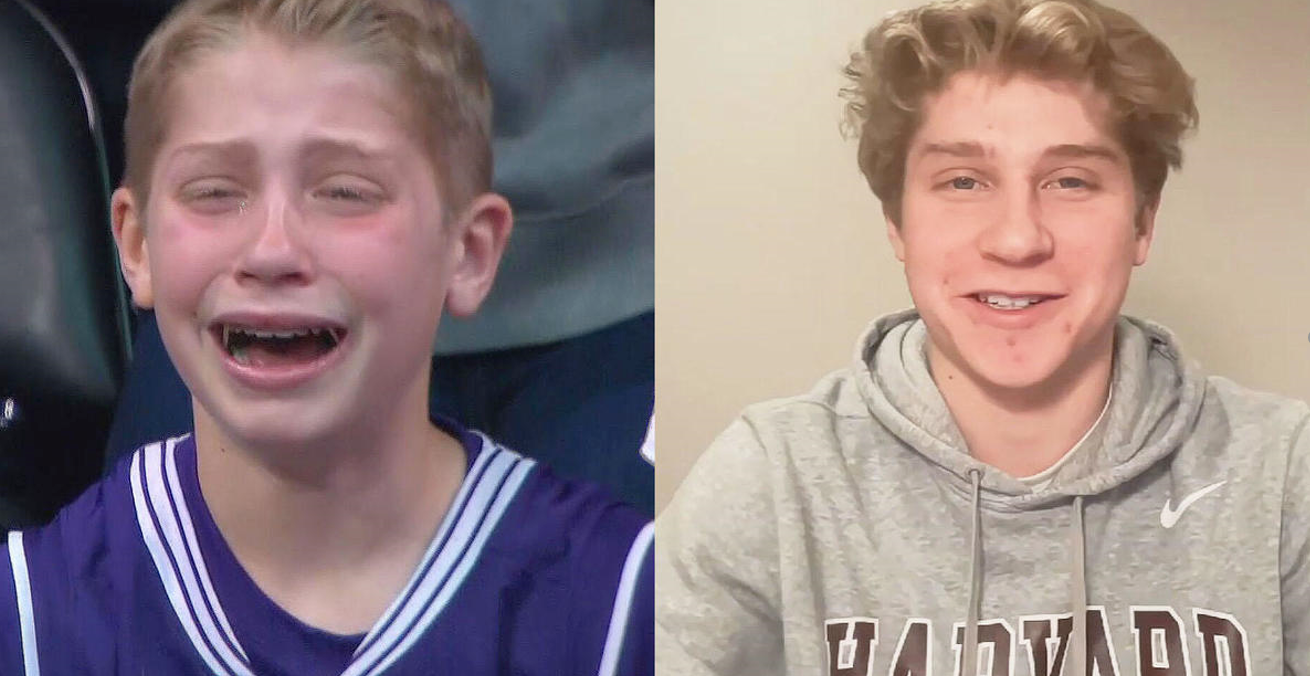

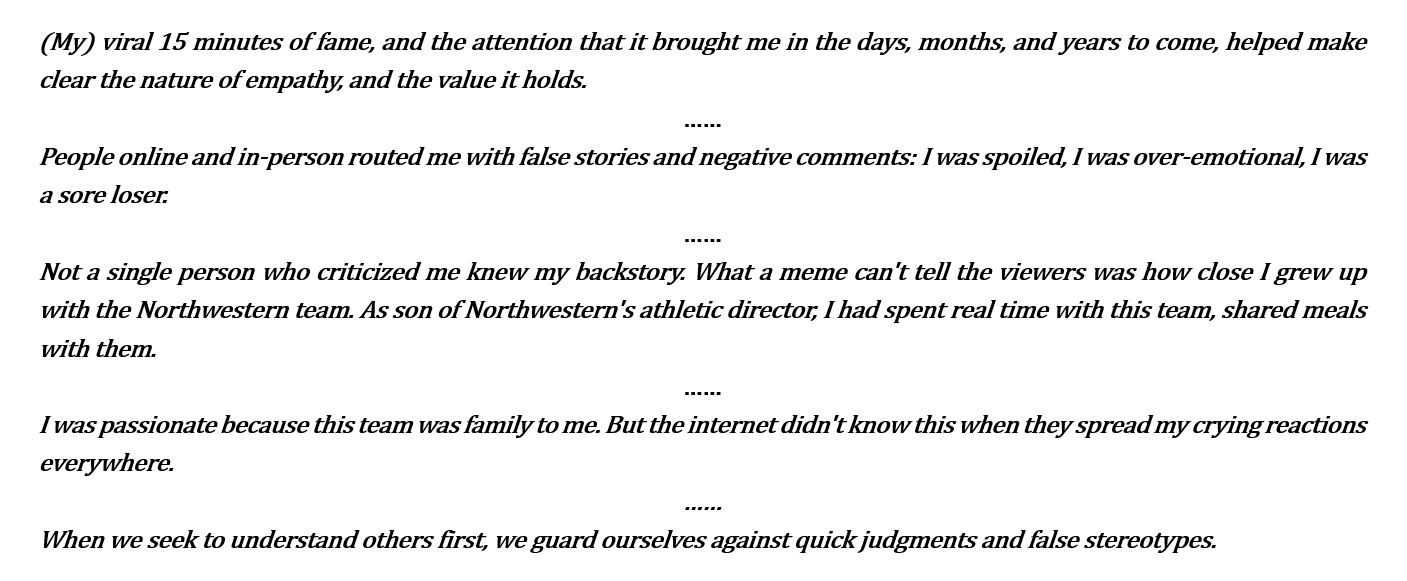
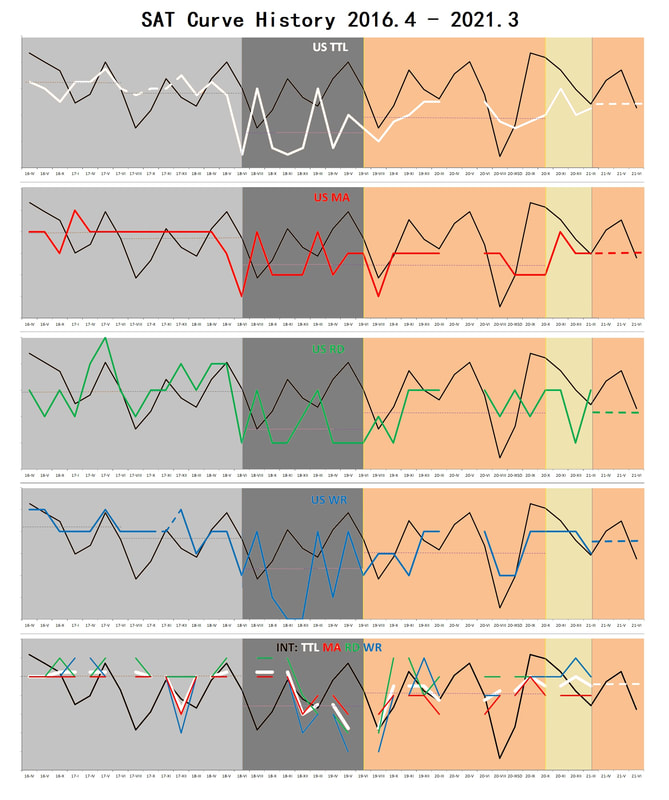
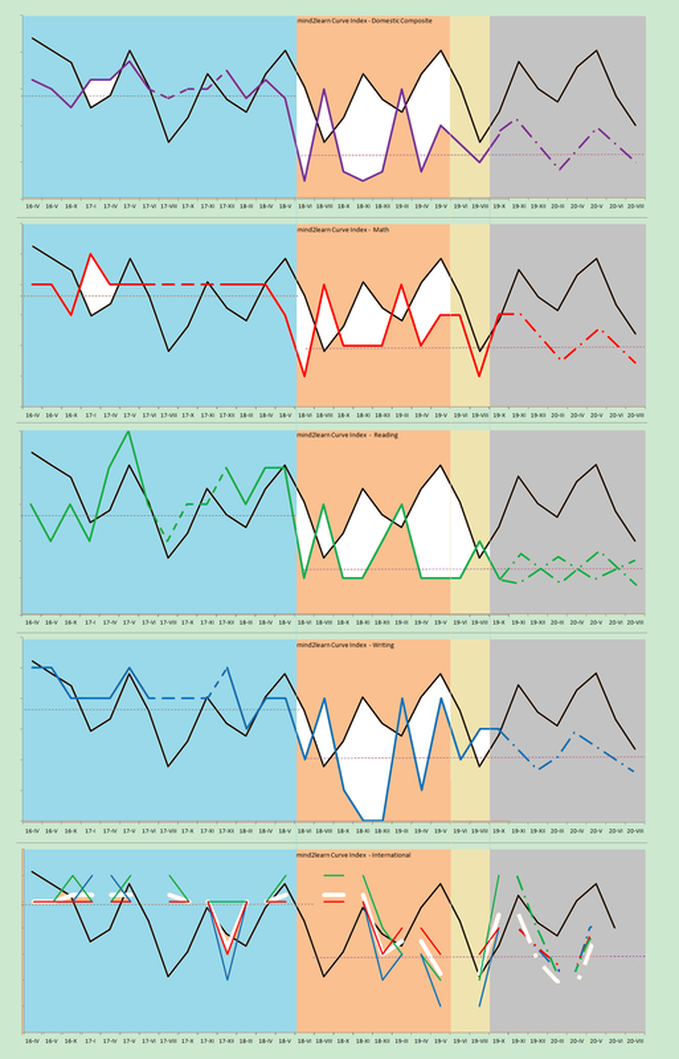
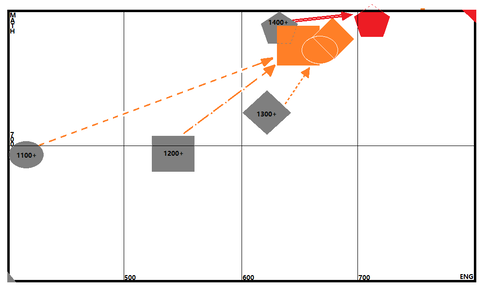
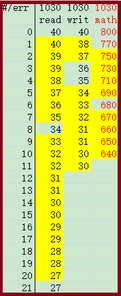
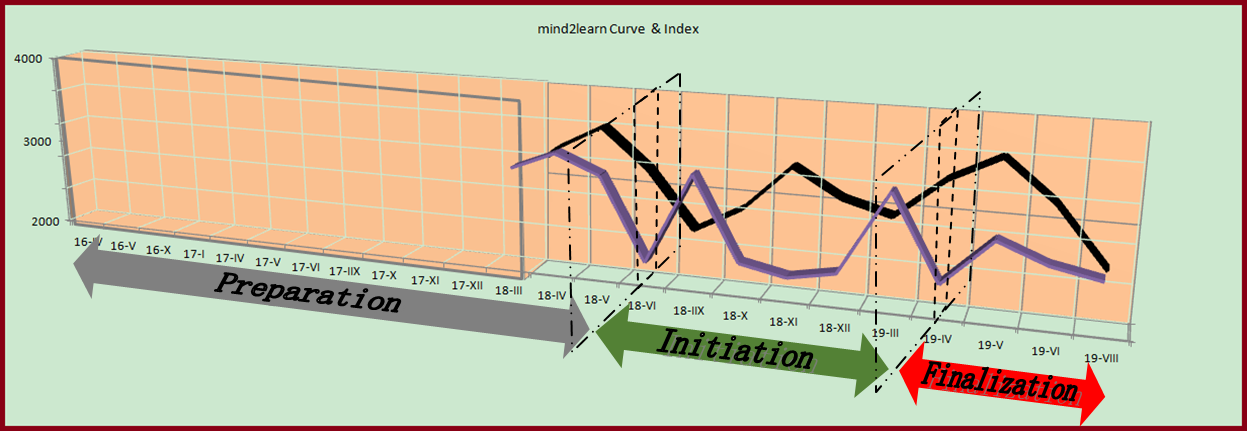
 RSS Feed
RSS Feed
